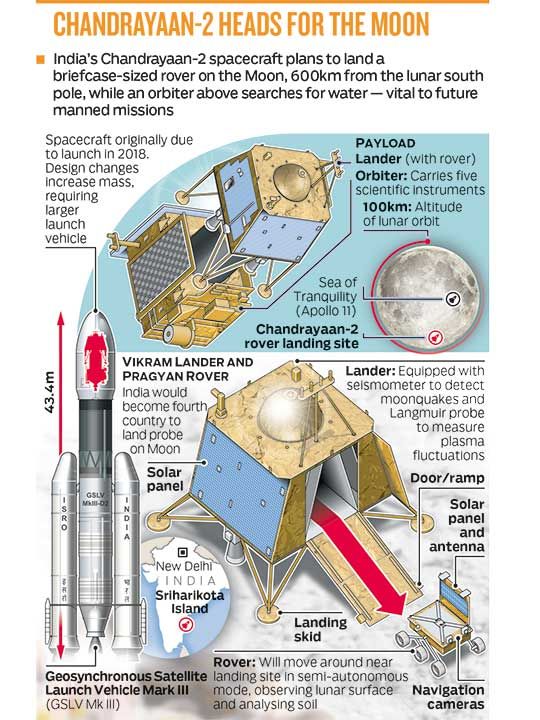
Satish Dhawan Space Centre, Sriharikota: India is on its way to the moon.
One week after a first attempt was cancelled at the last minute, the Chandrayaan-2 (meaning Moon Chariot 2) mission blasted off at 2.43pm Monday from the Satish Dhawan Space Centre on India’s southeast coast, carrying an unmanned lunar lander, the country’s national pride and space ambitions.
Why is this mission a big deal?
India is seeking to become just the fourth nation after Russia, the United States and China to land a spacecraft on the Moon. If the rest of the mission goes to plan, the Indian probe will land on the lunar South Pole in early September. It would be a huge leap forward for the country’s ambitious space programme, and scientists and defence experts everywhere are watching to see whether the Indians can pull it off. “Every Indian is immensely proud today!,” tweeted Indian Prime Minister Narendra Modi, who has vowed to send a manned mission into orbit by 2022. “Special moments that will be etched in the annals of our glorious history!”
How were the initial reactions?
There were applause, handshakes and hugs in the mission control room as the rocket blasted off from the base on an island just off the coast of Andhra Pradesh state. President Ram Nath Kovind watched the launch alongside 7,000 dignitaries and flag-waving children, with the crowd bursting into cheers at the spectacle. “Today is a historic day for space, science and tech in India,” Indian Space Research Organisation (Isro) chief K. Sivan said as he hailed the efforts made to fix a fuel leak that forced the earlier launch to be postponed. India was also hailed by its international counterparts. The US State Department said on Twitter that the launch was “an incredible achievement!” while the European Space Agency sent congratulations.

Why was the launch cancelled last week?
Last week, Indian rocket scientists abruptly called off the launch less than an hour before lift-off. They had found a “technical snag”, they said. Scientists later disclosed that one of the helium tanks in the upper stage of the rocket had been slightly losing pressure. But on Monday, all systems were go for the first ever mission to the moon’s south pole. “The low-pressure issue got corrected,” said Vivek Singh, a spokesman for the Isro, India’s version of Nasa. “The mood is perfect. You know in space missions, you can’t go with 99 per cent confidence,” he added. “You should have 100 per cent confidence.”
How have Indians reacted to the launch?
Within India, the mission has stoked enormous pride, especially among schoolchildren who dream of being astronauts. Shortly before the launch, a huge crowd of space enthusiasts gathered at the gates. The weather was hot and muggy, around 90 degrees, with thick cloud cover and occasional drizzles. Cameras dangled from their necks and some, like Kaushal Vijay, 8, wore pins saying “I Love India.”
“It’s going to be like a missile going to the moon!” he said. “A lot of fire and noise.” His mother, Swetha Vijay, said she had not hesitated to pull her children out of school for the day. “I feel proud for my kids to see this,” she said. Huge video screens in the space centre’s media room alternated between live images of the rocket standing on the launch pad to shots of scientists and engineers sitting in rows in front of banks of computers at mission control.
Was the launch planned to coincide with the 50th anniversary of the Apollo mission?
The timing for this moon mission could not be more opportune. This weekend was the 50th anniversary of Neil Armstrong’s first steps on our little neighbour. All the anniversary coverage has uncapped a wave of moon fever around the world.
Indian space officials said the Apollo connection was just a coincidence. India had planned to do this mission several years ago as something of a joint venture in space with Russia. But after the Russians backed out because of problems in their own space programme, India needed to make all the systems itself, which caused a long delay.
What exactly is the mission all about?
The mission includes four components: a giant Geosynchronous Satellite Launch Vehicle — Mark III rocket (though it is much shorter and lighter than the Saturn V rocket that lifted the Apollo missions); an orbiter; a lander; and the small rover. The mission costs less than $150 million (Dh550 million, Rs10.4 billion), but will take much longer than the relatively straight shot made by the Apollo missions, which cost billions (the presence of humans along for the ride added to the price tag).
Why will the orbiter take such a long time to reach the moon?
The Indian orbiter will conserve fuel by making ever-widening orbits around the Earth before being captured by the moon’s gravity and pulled into lunar orbit. The whole journey will take more than five weeks. The lander will then drop down from the orbiter. After it touches down on the moon, Chandrayaan’s little solar-powered rover will chug out. This is scheduled for early September. The mission has been timed for the beginning of a moon day, so the rover can get maximum sunlight.








